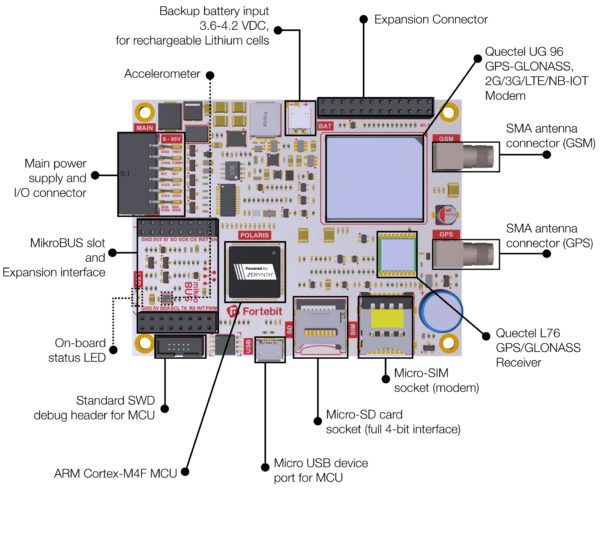Polaris is an open IoT platform that can be programmed in Python and is intended for cloud apps and remote logging. Excellent GPS/GLONASS car tracker with 2G, 3G, LTE, and NB-IOT modem options. The Polaris programme is open source so it may be readily modified and personalised. It is available in Python, Zerynth, or Arduino.
Polaris can serve as a GPS/GLONASS car tracker and has 2G, 3G, LTE, and NB-IOT modem options, but it can do so much more. It is an open IoT platform that can be programmed in Python and is prepared to connect to the cloud with just a few lines of code. Polaris is completely compatible with Arduino.
Geofencing, real-time tracking, analogue sensors, external instructions, audio, and SMS are just a few of the features that Polaris is built with.
The most well-known open-source car tracker board in the world, OpenTracker, which we created in 2014, has evolved into Polaris.
Python is the ideal programming language for IoT, in our opinion. Polaris is therefore Python-programmable and Zerynth-powered.
Zerynth (*) licence onboard enables Python programming directly out of the box. Zerynth also supports hybrid C/Python programming.
The entire Python programme is made available as open source. Here are links to download Zerynth Studio for Windows, macOS, and Linux (compatible with r2.4.0 – r2.5.0). Here you may find the documentation, API, and examples for Zerynth v2.
Polaris is completely compatible with Arduino. The Arduino IDE natively supports it, making use of the sizable Arduino code base.
On the GitHub channel, the complete Arduino application is made available as open source.
Improved Vehicle Tracking Cloud Platform from Polaris Cloud
You'll be happy to know that our upgraded car monitoring platform Polaris Cloud allows you to track many vehicles at once.
Simply link your smart cars and other vehicles. Following that, it will be simple to save and examine the collected vehicle data.
You simply need a SIM card to register the device on our online tracking system because the hardware is pre-programmed and ready to send tracking data out of the box. When the configuration is finished, your device will appear on the map.
Additionally, Polaris enables you to use it without a car battery by connecting a Li-Po battery. Because of its external power source, it may be attached to a bicycle, for instance.
It may be linked to a variety of sensors and can gather data from the CAN bus thanks to its numerous analogue inputs. The ability to directly operate relays or other external loads is also provided through a number of digital outputs. Then, it is simple to upload the sensor data to the cloud for remote monitoring. Because of this, Polaris is perfect for industrial machines where measurements of things like oil pressure, crane placement, and other things are necessary.
Polaris is highly adaptable in terms of expansion. There are several digital and analogue I/O ports, SPI, I2C, and UART communication interfaces, and a MikroBUSTM slot that enables the use of more than 600 Click boards. This implies that Polaris may be equipped with a wide range of capabilities, including motor control and motion sensors as well as OLED displays, buttons, and UV sensors.
Power supplies
- Main
power input 8-36 VDC (2A max), compatible with 12V/24V systems/vehicles
- Backup
battery input 3.6-4.2 VDC, for rechargeable Lithium cells
- Internal
3.3V and 5V supplies for add-on modules
- Several
low power modes (down to <50uA)
Wireless interfaces
- 2G Modem
(Quectel M95 – Quad-band GSM/GPRS Modem)
- 3G Modem
(Quectel UG96 – 5-band UMTS/HSPA, 4-band GSM/GPRS/EDGE, global coverage)
- NB-IOT Modem
(Quectel BG96 – LTE Cat M1/Cat NB1/EGPRS Modem)
- GPS/GLONASS
Receiver
Connectors and interfaces
- 2
SMA antenna connectors (GSM, GPS)
- Socket
for micro-SIM (modem)
- Micro
USB device port for MCU diagnostics/programming
- Standard
SWD debug header for MCU
- Main
power supply and I/O connector (2×6 pins, Micro-FIT type)
- MikroBUS
slot
- Generic
purpose expansion connector
- LiPo
battery connector
Storage
- Socket
for micro-SD card (full 4-bit interface)
- Quad-SPI
Serial Flash
Sensors
- 3-axis
Accelerometer
- MCU
temperature
Indicators
- On-board
status LED (controlled by MCU)


















0 Comments